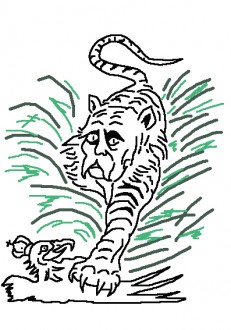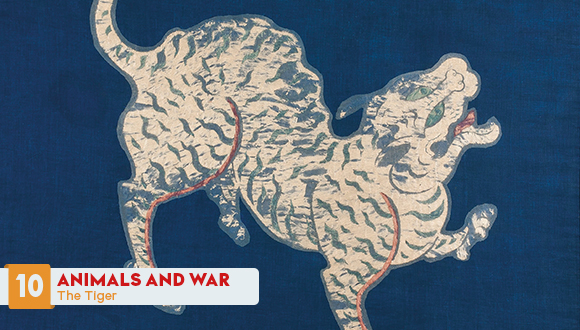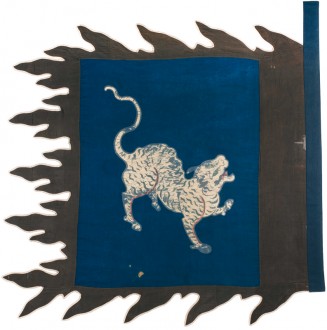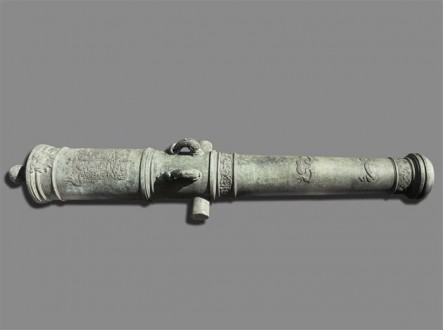The French captured this flag adorned with a white tiger during the Tonkin War in 1885, along with eight other flags. It is hanging from one of the cornices of the Saint-Louis-des-Invalides Cathedral. At the end of the nineteenth century, the Black Flag Army played a major role in fighting against French imperialism in Upper Tonkin. Symbol of prowess and ferocity in Chinese culture, the white tiger is one of the Four Symbols of the Chinese constellation, representing the west and one of the one of the twelve branches of the Chinese zodiac. In Imperial China, the Tiger mandarin square, or rank badge was worn by a military official of the 4th military rank (on 9). It is also associated with the season of autumn and the white colour in the five Chinese Elements.
Fortress Canon El Tigre. The Spanish fortress canon “El Tigre” (The Tiger) bears the arms of King Charles III (1716-1788) of Spain. The name of the canon “El Tigre” is engraved close to the mouth of the gun. The French captured this artillery piece during the Battle of Veracruz, which took place in 1838, in Mexico. Another model of this canon, currently kept at the Castle of San Cristóbal in Santa Cruz de Tenerife, became legendary after it fired the musket ball that wounded Rear-Admiral Horatio Nelson who lost his right arm during the Battle of Santa Cruz de Tenerife on July 25, 1797. © Paris, musée de l’Armée, Dist. RMN-GP / Émilie Cambier.
Insignia of the 9th Regiment of Zouaves. The 9th Zouaves was created in 1914. It distinguished itself during the two World Wars during which it was awarded the Légion d’Honneur and was recommended several times in the Ordre de l’Armée. In December 1914, French GHQ nicknamed the regiment “the Tigers of the 9th” because of its courage. This insignia was designed around 1935. It represents a golden tiger with striations of black enamel, leaping from the circle of the number “nine” made of red enamel intertwined with a blue enamelled letter “Z”. On the number, the motto of the 9th Regiment of Zouaves in gilded letters reads as follow: “JACKALS IN ALGERIA – TIGERS AT VERDUN”. The regiment was disbanded in 1962. © Paris, musée de l’Armée, Dist. RMN-GP / Émilie Cambier.
The tiger
Power and Fear
Since Antiquity, the symbolic power of the tiger which combines both strength and power, has not lost its meaning. The remains of tigers are used as war ornaments by the combatants for the sole purpose to take ownership of the qualities of the animal. The tiger also adorns a great number regimental insignia. This symbolic appropriation is still very strong nowadays, as seen during the Sri Lankan Civil War (1983-2009), which opposed the Sinhalese majority with the minority Sri Lankan Tamils, the so-called Liberation Tigers of Tamil Eelam (LTTE). This separatist organization founded in 1976, advocated the formation of an independent sovereign state, the Tamil Eelam. The main strategy of Tamil Tigers was guerrilla warfare and targeted bombings.
War machines
Is it because of its warlike qualities that the name of the tiger became the name of war machines? The museum exhibits several weapons bearing the name of the beast, such as a Spanish cannon dating from the eighteenth century and a rifle manufactured around 1700, used by successive Chinese emperors throughout the eighteenth and nineteenth centuries. During the Second World War, the Panzerkampfwagen VI Tiger, commonly referred to as Tiger I, was a German heavy tank used for the first time on the Eastern Front in 1942, during the Battle of Leningrad. Tiger tanks also took part in Battle of Normandy in 1944, but their lack of mobility when crossing the high banks made them vulnerable and many tank-crews abandoned it.
Nowadays, one of the attack helicopters used in the French Army Light Aviation is the Eurocopter Tiger, nicknamed “The Tiger”. Developed and built by Airbus Helicopters, it entered service in 2003. The Tiger HAD EC665 provides support-protection, the Tiger HAD EC 665 support-destruction. The building programme of this helicopter is the responsibility of the Organisation for Joint Armament Cooperation (OCCAR), initially established by France and the German Federal Republic, and then joined by Spain. This helicopter is also used in Australia.

Nowadays, the insignia of French Central Directorate of the Judicial Police (DCPJ) features a tiger’s head with Clemenceau’s profile.
 Illustration from a drawing of Sem published in March 1919 on the cover of the newspaper La Baïonnette. In 1906, Émile Buré (1876-1952), a former fellow political journalist at the French newspaper l’Aurore edited by George Clémenceau (1841-1929), who had followed him as his executive director in the French Ministry of Finances, declared that one day, as he saw Clémenceau threatening a Prefect, he “… thought [he] saw a Tiger in action”. In the Chambre des Députés, during his relentless opposition to Jules Ferry, Clémenceau became known as “the destroyer of Ministries”. Following his appointment as minister of the Interior, Clemenceau’s reputation as an uncompromising, fierce and controlling man earned him the nickname “The Tiger”. In 1917, he created the famous Brigades du Tigre, regional mobile squads, the forerunner to French criminal police, named after Clémenceau himself. In 1917, Clemenceau, who had resigned from politics, was appointed Prime Minister. His strong determination to pursue the war earned him the nickname “Father Victory”. © Paris, musée de l’Armée Illustration from a drawing of Sem published in March 1919 on the cover of the newspaper La Baïonnette. In 1906, Émile Buré (1876-1952), a former fellow political journalist at the French newspaper l’Aurore edited by George Clémenceau (1841-1929), who had followed him as his executive director in the French Ministry of Finances, declared that one day, as he saw Clémenceau threatening a Prefect, he “… thought [he] saw a Tiger in action”. In the Chambre des Députés, during his relentless opposition to Jules Ferry, Clémenceau became known as “the destroyer of Ministries”. Following his appointment as minister of the Interior, Clemenceau’s reputation as an uncompromising, fierce and controlling man earned him the nickname “The Tiger”. In 1917, he created the famous Brigades du Tigre, regional mobile squads, the forerunner to French criminal police, named after Clémenceau himself. In 1917, Clemenceau, who had resigned from politics, was appointed Prime Minister. His strong determination to pursue the war earned him the nickname “Father Victory”. © Paris, musée de l’Armée |





Ajouter un commentaire